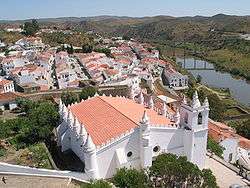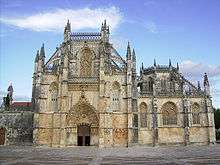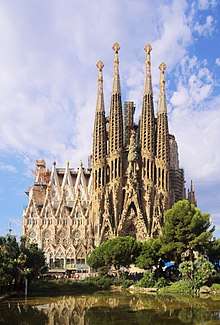Moorish architecture
Moorish architecture is an architectural style which historically developed in the western Islamic world, which included al-Andalus (Muslim-ruled Spain and Portugal between 711 and 1492), Morocco, and much of Algeria, Tunisia, and Libya (part of the Maghreb).[1][2][3][4][5] The term "Moorish" comes from the European designation of the Muslim inhabitants of these regions as "Moors".[6][7] The style blended influences from Berber culture in North Africa, pre-Islamic Iberia (Roman, Byzantine, and Visigothic), and contemporary artistic currents in the Islamic Middle East to elaborate a unique style over centuries with recognizable features such as the "Moorish" arch, riad gardens (courtyard gardens with a symmetrical four-part division), and elaborate geometric and arabesque motifs in wood, stucco, and tilework (notably zellij).[1][2][7][8] Major centers of this artistic development included the main capitals of the empires and Muslim states in the region's history, such as Cordoba, Kairouan, Fes, Marrakesh, Seville, Granada and Tlemcen.[1]
.jpg)
| Part of a series on |
| Islamic studies |
|---|
| Jurisprudence |
| Science |
| Arts |
| Architecture |
| Other topics |
Even after Muslim rule ended in Spain and Portugal, the legacy of Moorish architecture was carried on in the Mudéjar style in Spain, which made use of Moorish techniques and designs and adapted them to Christian patrons.[9][5] Much later, particularly in the 19th century, the Moorish style was frequently imitated or emulated in the Neo-Moorish or Moorish Revival style which emerged in Europe and America as part of the Romanticist interest in the "Orient" and also, notably, as a recurring choice for new Jewish Synagogue architecture.[10][11]
Architecture
Characteristic elements of Moorish architecture include horseshoe or "Moorish" arches, interlacing arches, central courtyards, riad gardens, intricately carved wood and stucco as decoration, muqarnas sculpting, and decorative tile work known as zellij in Arabic or azulejo in Spanish and Portuguese.[1] The architectural tradition is exemplified by mosques, madrasas, palaces, fortifications, hammams (bathhouses), funduqs (caravanserais), and other historic building types common to the Islamic world.[1] Notable examples include the Mezquita in Córdoba (784–987, in four phases); the ruined palace-city of Medina Azahara (936–1010); the church (former mosque) San Cristo de la Luz in Toledo; the Aljafería in Zaragoza; the Alhambra (mainly 1338–1390[12]) and Generalife (1302–9 and 1313–24) in Granada; the Giralda in Seville (1184);[13] the Kutubiyya Mosque, Hassan Mosque, Andalusian Mosque, and al-Qarawiyyin Mosque in Morocco; the Great Mosque of Algiers and the Great Mosque of Tlemcen in Algeria; and the Mosque of Uqba in Kairouan, Tunisia.[1]
The term is sometimes used to include the products of the Islamic civilisation of Southern Italy.[14] The Palazzo dei Normanni in Sicily was begun in the 9th century by the Emir of Palermo. There is even archaeological evidence of an eighth-century mosque in Narbonne, France, at the limits of Muslim expansion in the region in the 8th century.[15]
By country
Spain
- Alicante
- Castle of Santa Bárbara
- Antequera
- Almería
- Badajoz
- Bailén
- Baños de la Encina Castle (Burgalimar)
- Córdoba
- The great mosque
- Medina Azahara
- Caliphal Baths
- Calahorra Tower
- Gormaz
- Gormaz Castle
- Granada
- Alhambra and Generalife
- Cuarto Real de Santo Domingo
- Alcázar Genil
- Madraza
- Albayzín
- Jaén
- Jerez de la Frontera
- Alcazar
- Málaga
- Mérida
- Seville
- Toledo
- Mosque of Cristo de la Luz
- Mezquita de las Tornerías
- Trujillo
- Alcazaba
- Zaragoza
Major monuments
Caliphate of Córdoba (929–1031):
- Great Mosque of Cordoba (founded in 784, enlarged in 10th century)
- Medina Azahara (936–1010) in Córdoba
- Mosque of Cristo de la Luz in Toledo (completed 999/1000)
- "Minaret of San Juan" (930) at Córdoba, once belonging to a mosque
- Archaeological site of the Villarrubia palace (965–66)
Period of Taifas (11th–13th century):
- The Mezquita de las Tornerías in Toledo (ca. 1060)
- The Almohad minaret known as Giralda (1184–98) at Sevilla, once part of the Great Mosque of Sevilla (1172–1176)
- Aljaferia palace (second half of the 11th century) of the Banu Hud dynasty (1039–1110) in Zaragoza
- Minaret at the Church of San José at Granada (ca. 1050)
- Almohad Minaret at Iglesia de San Juan de los Reyes at Granada
Nasrid Emirate of Granada (1212–1492):
- The Alhambra (mainly 1338–1390) and the Generalife (1302–24 in two phases), a country palace initially linked to the Alhambra by a covered walkway across the ravine that now divides them.
- Granada Hospital (Maristan) (1365–7)
- Masjid of the madrasa of Yusuf I (1349) in the so-called Palacio de la Madraza
- New Funduq of Granada (14th century)
- Qaysariyya of Granada (15th century)
Portugal

- Algarve (Al-Garb Al-Andalus)
- Albufeira
- Paderne Castle
- Silves
- Silves Castle
- Albufeira
- Alentejo
- Mértola
- Mosque of Nossa Senhora da Anunciação
- Mértola
- Estremadura
Gallery
 Mosque–Cathedral of Córdoba, Spain – Horseshoe Arch
Mosque–Cathedral of Córdoba, Spain – Horseshoe Arch.jpg) Mosque–Cathedral of Córdoba, Spain – Double horseshoe arches allowing for greater ceiling height
Mosque–Cathedral of Córdoba, Spain – Double horseshoe arches allowing for greater ceiling height Alcazaba of the Alhambra, Granada
Alcazaba of the Alhambra, Granada Alhambra, Granada, Spain – central court and gardens were a typical Moorish feature
Alhambra, Granada, Spain – central court and gardens were a typical Moorish feature Court of the lions, Alhambra Spain
Court of the lions, Alhambra Spain- Muqarnas in the Alhambra, Granada, Spain – muqarnas allowed for 2 dimensional patterns to be used in 3 dimensions to embellish the transition between the square base to a dome.
See also
- Islamic architecture
- Arab-Norman culture
- Islamic influences on Christian art
- Moorish Revival
- Moroccan architecture
- Mudéjar
- Mudéjar Architecture of Aragon
- List of former mosques in Spain
- List of former mosques in Portugal
References
- Marçais, Georges (1954). L'architecture musulmane d'Occident. Paris: Arts et métiers graphiques.
- Parker, Richard (1981). A practical guide to Islamic Monuments in Morocco. Charlottesville, VA: The Baraka Press.
- Gaudio, Attilio (1982). Fès: Joyau de la civilisation islamique. Paris: Les Presse de l'UNESCO: Nouvelles Éditions Latines. ISBN 2723301591.
- Touri, Abdelaziz; Benaboud, Mhammad; Boujibar El-Khatib, Naïma; Lakhdar, Kamal; Mezzine, Mohamed (2010). Le Maroc andalou : à la découverte d'un art de vivre (2 ed.). Ministère des Affaires Culturelles du Royaume du Maroc & Museum With No Frontiers. ISBN 978-3902782311.
- Dodds, Jerrilynn D., ed. (1992). Al-Andalus: The Art of Islamic Spain. New York: The Metropolitan Museum of Art. ISBN 0870996371.
- "moor | Origin and meaning of moor by Online Etymology Dictionary". www.etymonline.com. Retrieved 2020-06-09.
- Barrucand, Marianne; Bednorz, Achim (1992). Moorish architecture in Andalusia. Taschen. ISBN 3822876348.
- Bennison, Amira K. (2016). The Almoravid and Almohad Empires. Edinburgh University Press.
- López Guzmán, Rafael. Arquitectura mudéjar. Cátedra. ISBN 84-376-1801-0.
- Giese, Francine; Varela Braga, Ariane; Lahoz Kopiske, Helena; Kaufmann, Katrin; Castro Royo, Laura; Keller, Sarah (2016). "Resplendence of al-Andalus: Exchange and Transfer Processes in Mudéjar and Neo-Moorish Architecture". Asiatische Studien – Études Asiatiques. 70 (4): 1307–1353.
- "Why Moorish? Synagogues and the Moorish Revival". Museum at Eldridge Street. 2017-04-27. Retrieved 2019-11-17.
- Curl p.502
- Pevsner, Niklaus. The Penguin Dictionary of Architecture
- The Industrial Geography of Italy, Russell King, Taylor & Francis, 1985, page 81
- Islam Outside the Arab World, David Westerlund, Ingvar Svanberg, Palgrave Macmillan, 1999, page 342
Bibliography
| Wikimedia Commons has media related to Architecture of Al-Andalus. |
- Curl, James Stevens (2006). A Dictionary of Architecture and Landscape Architecture (Paperback) (Second ed.). Oxford University Press. p. 880 pages. ISBN 0-19-860678-8.
- Barrucand, Marianne; Bednorz, Achim (2002). Moorish Architecture in Andalusia. Taschen. p. 240 pages. ISBN 3-8228-2116-0.

.jpeg)

